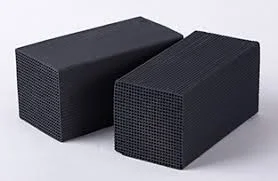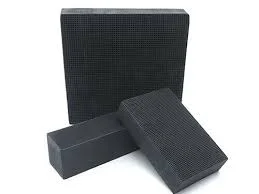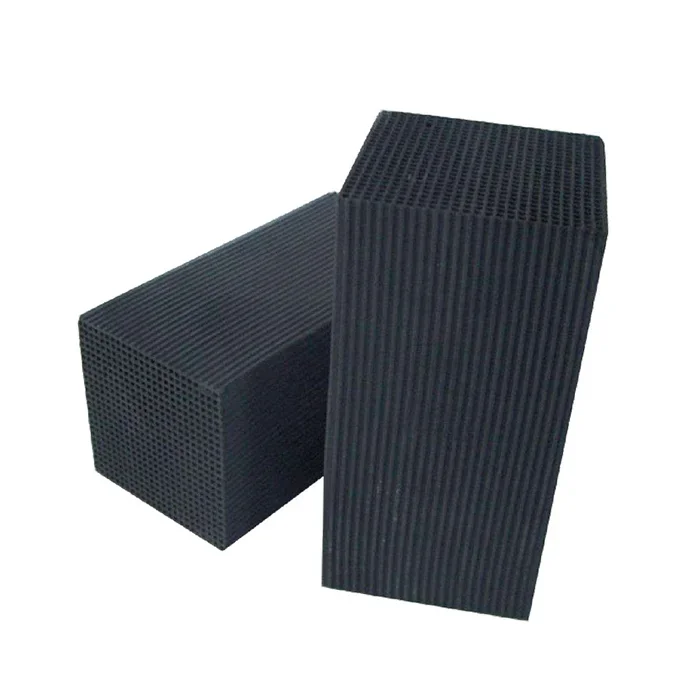In the realm of environmental protection and industrial waste management, honeycomb activated carbon blocks have emerged as a pivotal technology. These advanced materials are designed to tackle a variety of challenges, from catalytic combustion to the treatment of volatile organic compounds (VOCs) and the removal of harmful gases. This article delves into the distinctive characteristics that make honeycomb activated carbon blocks an essential component in various industrial applications.
Introduction
Honeycomb activated carbon blocks are a type of activated carbon with a honeycomb structure. They are known for their high efficiency in adsorption, which is crucial for purifying gases and liquids. The unique structure of these blocks provides a large surface area for adsorption, making them highly effective in capturing pollutants. Let's explore the features that set honeycomb activated carbon blocks apart.

Large Specific Surface Area
One of the most characteristics of honeycomb activated carbon blocks is their large specific surface area. This characteristic is a result of the intricate honeycomb structure, which allows for a vast number of micropores. The surface area of activated carbon is critical because it determines the amount of adsorbate that can be held on the surface of the material. A larger surface area means a higher adsorption capacity, which is why honeycomb activated carbon blocks are so effective in applications such as industrial waste gas treatment and solvent recovery.
High Adsorption Capacity and Strong Adsorption Force
The high adsorption capacity of honeycomb activated carbon blocks is a direct result of their large specific surface area. The micropores within the blocks are densely distributed, which means there are more sites available for adsorption. This not only increases the capacity for adsorbing pollutants but also enhances the strength of the adsorption force. Stronger adsorption forces mean that pollutants are held more securely, reducing the likelihood of them being released back into the environment.
Developed Pores and Low Wind Resistance
The structure of honeycomb activated carbon blocks also includes developed pores, which contribute to their effectiveness. These pores are not only numerous but also well-developed, allowing for efficient gas flow through the material. This is particularly important in applications where the blocks are used in ventilation systems or air purification units, as it reduces wind resistance and ensures that air can pass through without significant pressure drop.
Hongrun Purification Honeycomb Activated Carbon Blocks: Reliable Purification Solution
Advantage of Hongrun Purification honeycomb activated carbon blocks is their diverse specifications. Hongrun Purification can produce activated carbon blocks in various sizes and shapes to meet the specific needs of different industries.

Applications Fields
The versatility of honeycomb activated carbon blocks is evident in their wide range of applications. Here are some of the key areas where these blocks are used:
Catalytic Combustion Equipment: In catalytic combustion, honeycomb activated carbon blocks serve as a support for catalysts, providing a surface for the catalyst to interact with the pollutants, thus facilitating their breakdown.
Industrial Waste Gas Treatment: These blocks are used to remove harmful gases from industrial processes, reducing the environmental impact of these emissions.
VOCs Organic Waste Gas Treatment: VOCs are a significant contributor to air pollution, and honeycomb activated carbon blocks are effective in capturing these compounds before they are released into the atmosphere.
Spray Paint Room and Spray Workshop Waste Gas Treatment: In these environments, the blocks help to remove solvents and other volatile compounds that can be harmful to workers and the environment.
Removal of Harmful Gases: Beyond VOCs, honeycomb activated carbon blocks can also capture other harmful gases such as formaldehyde, which is particularly important in applications like fish tank fish farming, where the health of the aquatic life is at stake.
Solvent Recovery: In industries that use large amounts of solvents, these blocks can be used to recover solvents from exhaust streams, reducing waste and saving costs.
Fish Tank Fish Farming: In aquaculture, honeycomb activated carbon blocks are used to remove impurities and maintain water quality, ensuring the health of the fish.

Conclusion
Honeycomb activated carbon blocks are a powerful tool to fight pollution and protect the environment. Its unique structure provides a large adsorption surface area, high adsorption capacity and strong adsorption force, making it an ideal choice for a variety of industrial applications.
The Guide to Honeycomb Activated Carbon Blocks: Benefits and Applications

